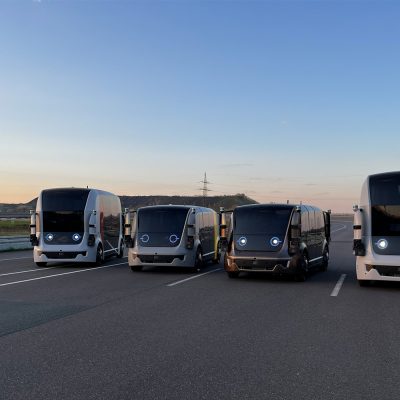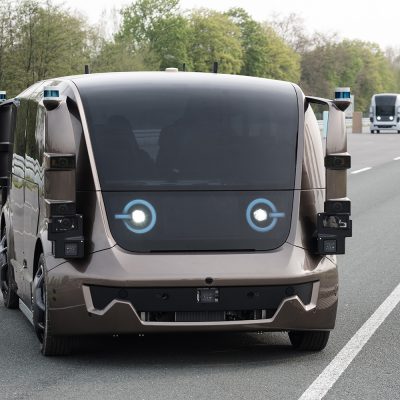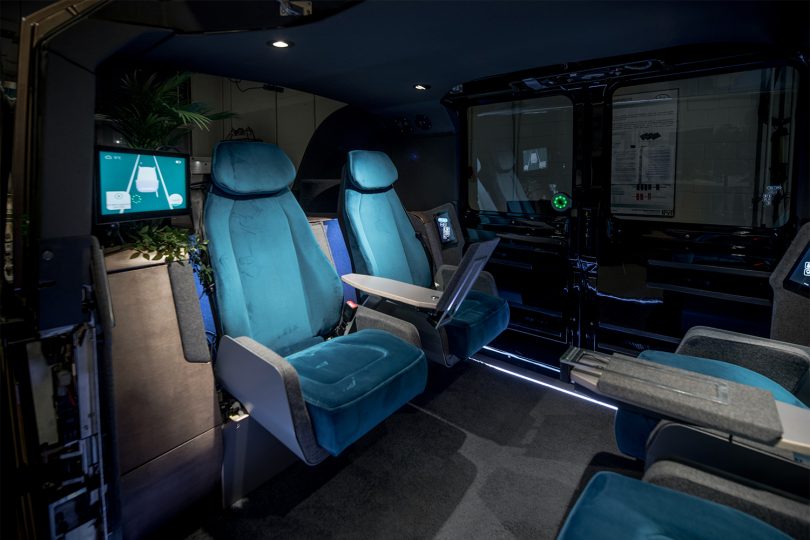Fully automated and driverless UNICARagil shows how driverless vehicles can drive safely in mixed traffic
- Final event of one of the largest research projects on autonomous driving presents 4 fully driverless vehicle prototypes,
- In the last five years, multi-university consortium developed completely new architecture, concepts and software for driverless vehicles.
- “Group photo”: All four use cases in the unicaragil project. Photo credit: Timo Woopen
- Interior of the family vehicle autoELF. Photo credit: Tobias Schräder
- In the foreground: the autoELF family vehicle. Photo credit: Tobias Schräder
After five years of intensive work, eight universities and nine companies presented their results to the public on 11 May 2023. Four fully autonomous vehicle prototypes now show how future mobility can succeed and at the same time fulfill complex tasks from individual and public transport as well as freight transport.
Automated and connected vehicles will play a key role in meeting the challenges posed by a growing demand for mobility and advancing urbanization. They create the basis for sustainable and intelligent road traffic, novel mobility and transportation concepts, and improvements in road safety and quality of life in urban and rural areas.
However, vehicle concepts suitable for this require much more powerful and updateable information processing in the motor vehicle and thus a revolution of established architectures and development processes. The prevailing approach in the automotive industry of an evolutionary further development of existing systems and concepts will only be able to achieve limited success due to numerous dependencies between hardware and software.
Therefore, the UNICARagil project, funded by the BMBF with about 32 million euros, involved a revolutionary rethink of the vehicle itself, its development and the underlying architectures. “Science must question what is known and create new knowledge—these are basically our core tasks and one of the cornerstones of our science location Germany,” says Prof. Lutz Eckstein, head of ika and overall coordinator of the project. “Therefore, we have set ourselves the task across universities to create an agile updateable and expandable architecture for driverless vehicles. We want to achieve this with the UNICARagil project in a tangible and convincing way.”
The aim of the project was therefore to create the foundations for a user-centred concept of driverless driving oriented to human capabilities through cooperation between leading German universities in the field of automated driving and specialized companies. For this reason, the project team deliberately refrained from converting or upgrading current vehicles. “Current vehicles represent answers to completely different requirements; they are geared toward humans as vehicle drivers. Simply removing the steering wheel now and installing an automatic steering and control system in the space thus freed up creates only limited added value. With the possibility of automation, we can also rethink the car itself,” says Timo Woopen, project manager at UNICARagil.
The project consortium therefore first developed a completely new vehicle structure without the legacy of current vehicles. Conventional vehicles basically consist of a chassis, a powertrain and a body. In UNICARagil, the chassis and drivetrain are combined into four dynamics modules, each of which drives, guides, steers and brakes a single wheel. These modules are connected to each other via a driving platform, which, thanks to the innovative wheel guidance system, can also steer all wheels through 90° and thus easily fit sideways into the smallest parking spaces. The cabins placed on the driving platform are individually designed according to the intended use of vehicles. This modular principle allows maximum flexibility in interior design with minimal development effort for future series production.
In order to automate vehicles in a meaningful way, not only a wide range of sensor technologies is required, but also modular control intelligence. In addition to the development of generic sensor modules, further research focuses were on environment recognition, a flexibly expandable and updateable software and hardware structure and, of course, the networking and safeguarding of all these elements. Just as the human brain transfers tasks to other brain areas in the event of minor injuries, for example, the UNICARagil prototypes are not based on a central computer. For this reason, a computer architecture was chosen that works on several levels, networking the so-called cerebrum with the brain stem and the dynamics modules and providing multiple protection for all tasks that arise.
The service-oriented software architecture allows agile updates that are integrated at runtime. The functional architecture additionally includes a cloud, where the actual learning from “experience” takes place, the road infrastructure such as sensors at traffic lights and so-called “info bees”, which are understood to be small automated aerial vehicles. The networking between these components enables the vehicles to interact with conventional cars and commercial vehicles in a predictive and safe manner, even in confusing traffic situations.
The consortium demonstrated the flexibility of the four driverless vehicle prototypes at the public closing event using different applications: The autoCARGO demonstrates fully automated parcel delivery, the autoTAXI how individual motto cabs can enable private or business meetings while driving to the train station in the future. The autoSHUTTLE represents a flexible addition to public transport by driving on routes in rural areas that are not in such high demand, and the autoELF vehicle model thematizes a private and customizable family vehicle.
Since the start of the project in February 2018, more than 100 project employees from 15 chairs and nine companies have been researching these innovative concepts for driverless vehicles and their implementation. The orchestration of the various competencies of the cooperating project partners has contributed significantly to looking at the complex issues of driverless driving from different perspectives and thus identifying and implementing new interdisciplinary approaches to solutions.
The final presentation of the four vehicle prototypes and the automated air vehicle at the Aldenhoven Test Center represented an important milestone for all those involved, because the project is not really over yet. On the one hand, the research results have been and will be presented and published at numerous conferences, and on the other hand, the findings of this project form a valuable basis on which vehicle manufacturers and other companies can build. Likewise, the follow-up project AUTOtech.agil has already started, which not only addresses still open questions of software and hardware architecture, but also creates the basis for an innovative and intelligent mobility system. The future has thus already begun.




